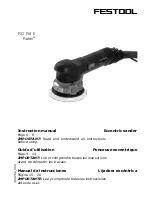
5
Technical data
Wattage
500 W
No load speed
2000 - 5600 rpm
Sanding stroke
5 mm (0.2 in.)
Sanding base dia.
150 mm (5.9 in.)
Weight
2.3 kg (5.1 lbs.)
Safety level
UL 745, CSA C22.2 No. 745
The illustrations mentioned can be found at the
beginning of the operating instructions.
Symbols
V
Volts
A
Amperes
Hz
Hertz
W
Watt
~
Alternating current
n
0
No load speed
Class II Construction
rpm
Revolutions per minute
Ø
Diameter
Intended use
The sanders are designed for sanding and
polishing wood, plastic, metal, stone, composite
materials, paint/varnish, filler and similar
materials.
Do not use with materials containing asbestos.
The tools must not be used when wet or damp,
or operated in a damp environment, for
electrical safety reasons. Use this sander only
for dry sanding.
The user bears sole responsibility
for any damage or accidents resulting from
incorrect use.
Electrical connection and operation
The mains voltage must correspond to the
voltage on the rating plate!
To start the tool, push the switch (1.1) forwards.
Slight pressure on the rear end of the switch is
sufficient to switch the tool off.
Extension cord
If an extension cord is required, it must have
sufficient cross-section to prevent an excessive
drop in voltage or overheating. An excessive
drop in voltage reduces the output and can lead
to failure of the motor. The table below shows
you the correct cord diameter as a function of
the cord length for the RO 150 E.
Use only U.L. and CSA listed extension cords.
Never use two extension cords together.
Instead, use one long one.
Note: The lower the AWG number, the stronger
the cord.
Electronic control
ELECTRONIC
The tool has full-wave electronics with
the following features:
Smooth start-up
The smooth start-up ensures jolt-free startup.
Various dust created by power
sanding, sawing, grinding, drilling and other
construction activities contains chemicals
known (to the State of California) to cause
cancer, birth defects or other reproductive
harm. Some examples of these chemicals are:
•Lead from lead-based paints,
•Crystalline silica from bricks and cement and
other masonry products,
•Arsenic and chromium from chemically-
treated lumber.
The risk from these exposures varies,
depending on how often you do this type of
work.
To reduce your exposure to these
chemicals work in a well
ventilated area and use approved
safety equipment, such as dust
masks that are specially designed
to filter out microscopic particles.
cutting edges are less likely to bind and are
easier to control.
g) Use the power tool, accessories and tool
bits etc., in accordance with these
instructions and in the manner intended for
the particular type of power tool, taking
into account the working conditions and
the work to be performed. Use of the power
tool for operations different from those intended
could result in a hazardous situation.
5) Service
a) Have your power tool serviced by a
qualified repair person using only identical
replacement parts. This will ensure that the
safety of the power tool is maintained.
To reduce the risk of injury,
user must read and understand instruction
manual.





































